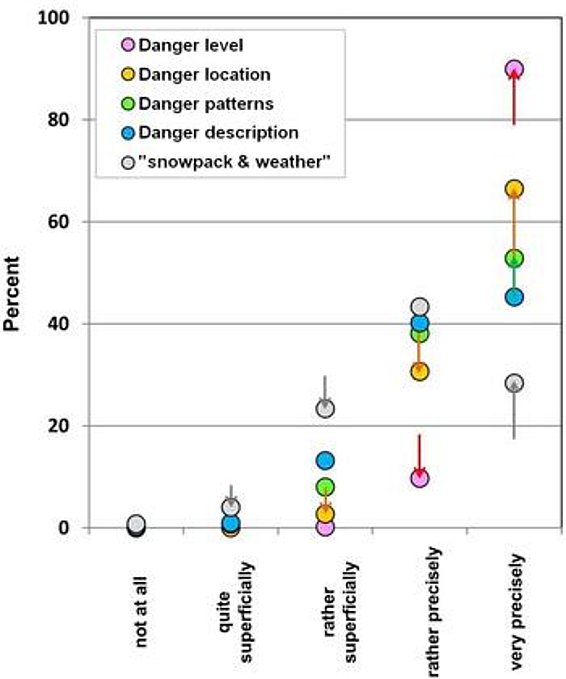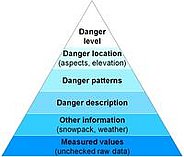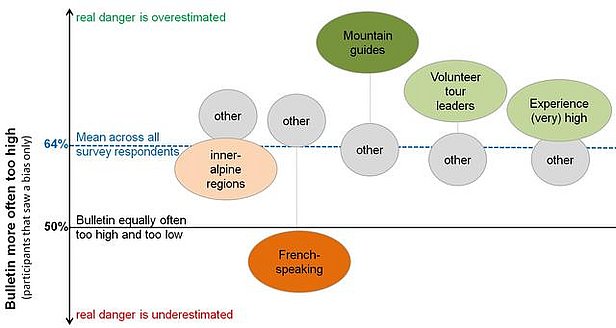Is the avalanche bulletin comprehensible? Does it reach all the groups of people that venture into avalanche prone terrain?
Answers to these and other questions were provided by approximately 2,500 people who took part in a user survey. The exercise revealed that the vast majority of users are highly satisfied with the avalanche bulletin and its supporting products. Comparing the outcomes with those of the survey undertaken in 2008 gives an additional insight into the impact of the revised bulletin format that was introduced at the start of the 2012/13 winter season. Some of the thought-provoking questions are analysed below.
Impact of the bulletin format ¶
Putting the most important topic first. The new Swiss avalanche bulletin strictly mirrors the information pyramid format recommended by the European Avalanche Warning Services. The content of the pyramid's top two tiers is repeated, moreover, to ensure that users are better able to recall the most important information.
The survey validates the pyramid structure – users' knowledge exactly reflects the sequence in which the information is presented. The extent to which they assimilate the content of 4 of the top 5 pyramid tiers has improved significantly since the new bulletin format was introduced.
When asked to rate the new avalanche bulletin against the old one, the majority of respondents indicated not only that it was more attractive and comprehensible, but also that its content was better. As a matter of fact, compared with 2008, the avalanche warning service had access to enhanced tools in 2014, including the mAvalanche app and the meteorological forecasting model COSMO2. The informational basis remained fundamentally unchanged, however, when the revised bulletin was launched. As a consequence, the content of the bulletin changed hardly at all when the new format was adopted, and is now only marginally different than it was in 2008. The survey results crucially show that only the bulletin content retained by users is useful, and that the extent of this portion is evidently greater with the new format.
Assement of the avalanche danger ¶

The dots show the scores for the new bulletin (2014). Scores that have changed significantly (by more than 4%) since 2008 are highlighted with an arrow.
"How much do you personally appreciate the avalanche bulletin forecasting precision?"
Although the question is simple, it generally elicits an equivocal response because the actual avalanche danger is usually impossible to judge even with hindsight. Against this background, the differences are more revealing than the absolute figures. At 83%, the mean value for rated accuracy was significantly higher than in 2008. Women and Italian speakers posted above-average ratings for forecasting accuracy, and mountain guides gave below-average scores.
"If in your opinion the avalanche bulletin is not right, do you then think the situation is usually
· more dangerous than reported (18%),
· less dangerous than reported (32%),
· in equal measure either more dangerous or less dangerous than reported (50%)."
A comparison of the responses "more dangerous" and "less dangerous" reveals significant differences between the diverse user groups, as illustrated by Figure 3:
Green: Experienced and highly trained persons (mountain guides, tour leaders, (very) experienced) considered the avalanche danger to be lower (in other words, frequently overestimated by the avalanche bulletin) than the other respondents. This outcome reinforces the impression that experienced, highly trained persons tend to regard their elevated skills as a licence to indulge in greater freedom, and not necessarily to improve safety while touring.
Pink: The actual avalanche danger is more often considered higher in the inneralpine regions than in the other regions (northern and southern flanks of the Alps). The avalanche warning service thus appears to underestimate the avalanche danger when the snowpack is poorly bonded (or to overestimate the danger when the bonding of the snowpack is good). Such a mismatch between estimation and reality is probably fairly commonplace – serious accidents occur more frequently when the bonding of the snowpack is poor.
Orange: French speakers more often rate the actual avalanche danger higher than the respondents who speak other languages. This finding gives rise to the question as to whether the danger levels are interpreted differently in France and Switzerland.

